Persian Butternut Squash and Chicken Stew
Prep: 20 mins
Cook: 2 hrs
Rest Time: 10 mins
Total: 2 hrs 30 mins
Servings: 4 Servings
Yield: 4 Servings
Khoresh, sometimes spelled Khoresht, refers to an entire classification of stews and braised dishes, and is a cornerstone of Persian cuisine.
The foundations of many Persian stews are saffron, tomatoes, pomegranate, or large quantities of herbs, and they can feature a wide range of vegetables and meats. Khoresh is frequently served with Persian steamed basmati rice, a medley of flatbreads, and side dishes such as yogurt and pickled vegetables.
This recipe celebrates the much-loved butternut squash of Autumn, cooked with tender pieces of chicken and dried plums. The broth is all about simplicity, but still offers a mouthwatering combination of tart lime juice balanced with a touch of sugar, finished off with a splash of bloomed saffron for good measure!
A more traditional recipe would use dried golden Persian plums (Aloo Bokhara). They are not only bright and beautiful in color, but more importantly, they are much more dynamic and flavorful than the traditional plum varieties, which tend to be just sweet. However, they need to be purchased at Persian markets or from online retailers, so in this recipe they have been replaced by the more accessible dried plum variety.
Making Persian Stews
Persian stews don't follow the simple approach of adding all the ingredients at the same time and cooking them together. Instead, there is a defined sequence for adding the ingredients.
- Turmeric is almost always present in stews, particularly when animal protein is involved, and is incorporated early in the process. It adds a gentle golden shade to the dish, and is commonly believed to take away any unpleasant “gaminess” of the meat.
- Salt is added later in the cooking process to avoid toughening the meat. Tough meat is never acceptable in Persian cuisine.
- Darker-colored spices such as black pepper and cinnamon are added later in the cooking process to avoid darkening the color of the broth.
- Saffron is added toward the very final stages of cooking to preserve its color, flavor, and aroma.
Serving Persian Stews
There is also an important concept called “Ja-oftaadan”, which roughly translates to “being set." This term covers methods to develop and highlight a stew’s richness, demonstrating the chef’s skills and knowledge.
- Persian stews are never runny or watery. Of course, the final consistency of the stew is impacted by many factors including the heat level, the size and style of the pan used, and the amount of moisture escaping the pan during cooking. So while it is essential to follow the recipe’s quantities and instructions, it is equally important to know what the final dish should look like. My tip is to imagine a plate filled with cooked rice on one side and stew on the other. While some of the liquid from the stew may be slowly absorbed into the rice, the stew should be thick enough that the rice is never drowned in liquid. If your Khoresh is running on the drier side during cooking, consider adding a little water. Alternatively, if the stew is too watery, increase the flame and partially tilt the lid so that some excess moisture is evaporated.
- Persian stews are rarely served piping hot fresh off the stovetop. Instead, they are removed from the heat source and allowed to sit for 10 to 15 minutes before being transferred to serving dishes. This resting period allows the cooking oil to gradually collect on the top of the stew, emphasizing its richness.
“This Persian stew is all about delicacy and balance. The sweet, tangy, and fruity notes create a delicious blend of aromas. Initially, the sauce might seem a little too thin, but it will thicken up after 15 minutes of resting and cooling.” —Diana Chistruga
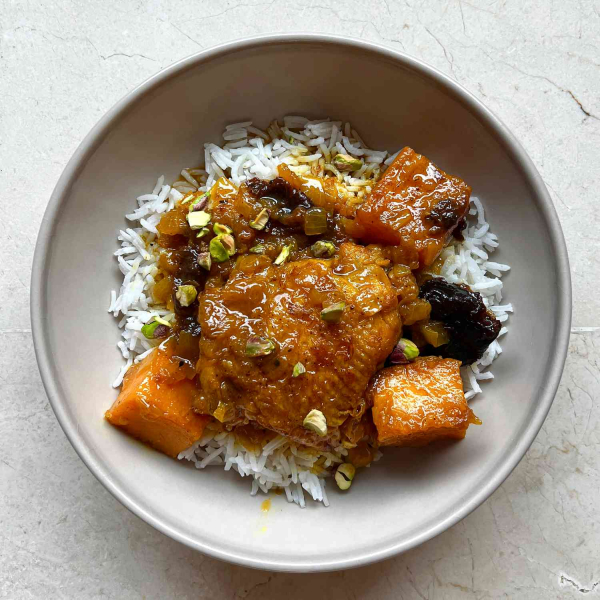
A Note From Our Recipe Tester
Ingredients
-
3 tablespoons olive oil, divided
-
1 small butternut squash, peeled and cut into 1.5-inch cubes, about 4 cups
-
4 chicken pieces (thighs or breasts, or a combination), with bone and skin on
-
1 large onion, diced
-
1/2 teaspoon ground turmeric
-
1 1/2 cups water
-
1/2 teaspoon ground cinnamon
-
1 teaspoon salt
-
1/2 teaspoon ground black pepper
-
2 tablespoons sugar, or more or less to taste
-
4 tablespoons fresh lime juice
-
1 cup pitted prunes
-
1/2 heaping teaspoon saffron threads, ground and dissolved in 2 tablespoons water
-
2 tablespoons pistachios, slivered or chopped
Steps to Make It
-
Gather the ingredients.
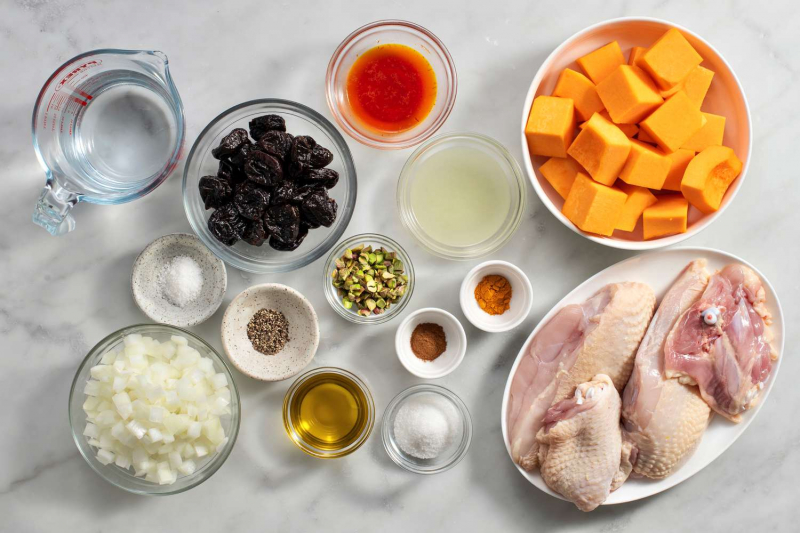
-
Saute the butternut squash with 2 tablespoons of the olive oil in a large dutch oven for 10 minutes or until lightly golden brown. Remove from the pan and set aside.

-
Add the remaining 1 tablespoon of oil and saute the chicken pieces for 3 to 5 minutes on each side to give them a touch of color. Remove the chicken from the pot and set it aside.
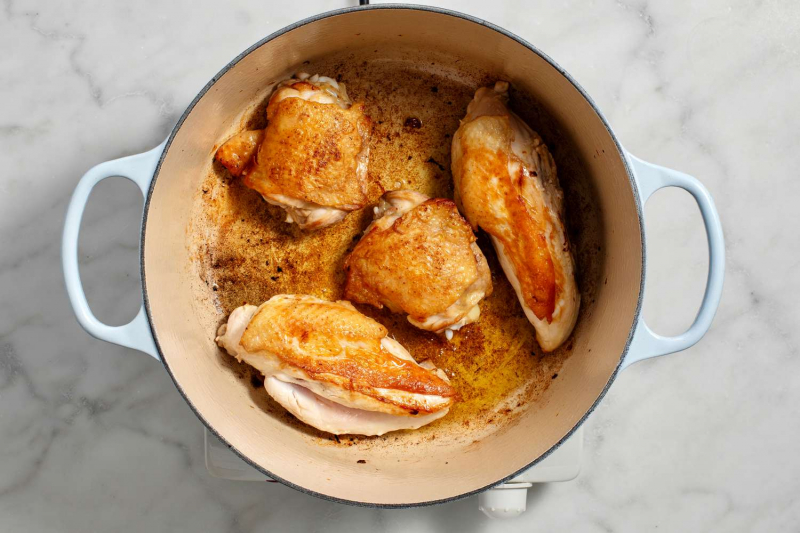
-
Discard all but 2 tablespoons of oil in the pot, add the onion, and saute for 10 minutes.

-
Add turmeric and saute for 2 more minutes.
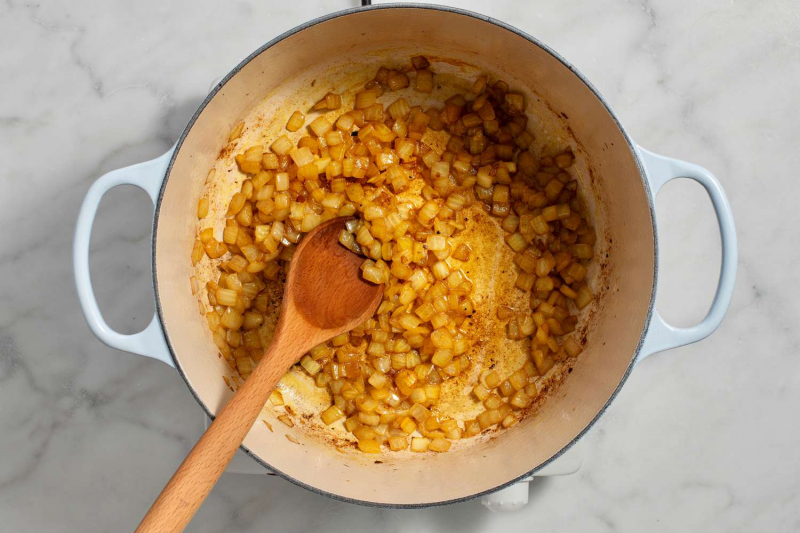
-
Add the chicken back to the pot, then add the water. Cover and simmer on low heat for 60 minutes.
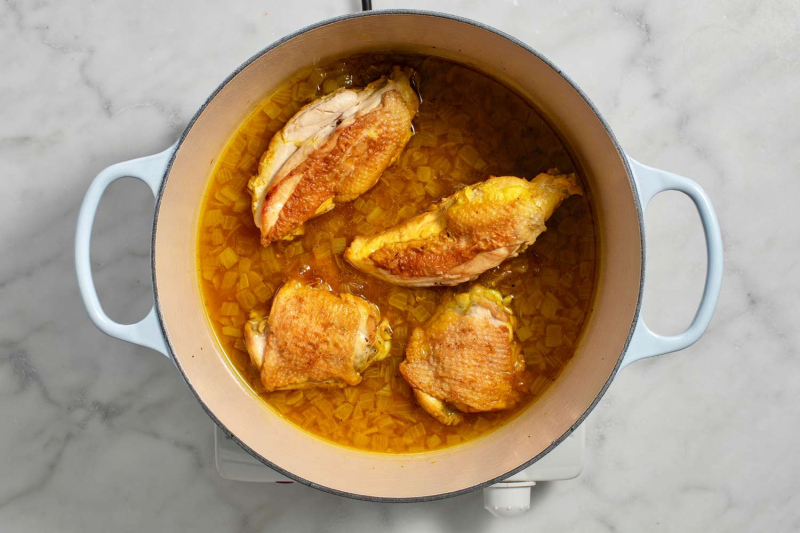
-
Add cinnamon, salt, pepper, sugar, lime juice, prunes, and the butternut squash. Continue to cook covered for another 30 minutes, or until the chicken is completely tender.
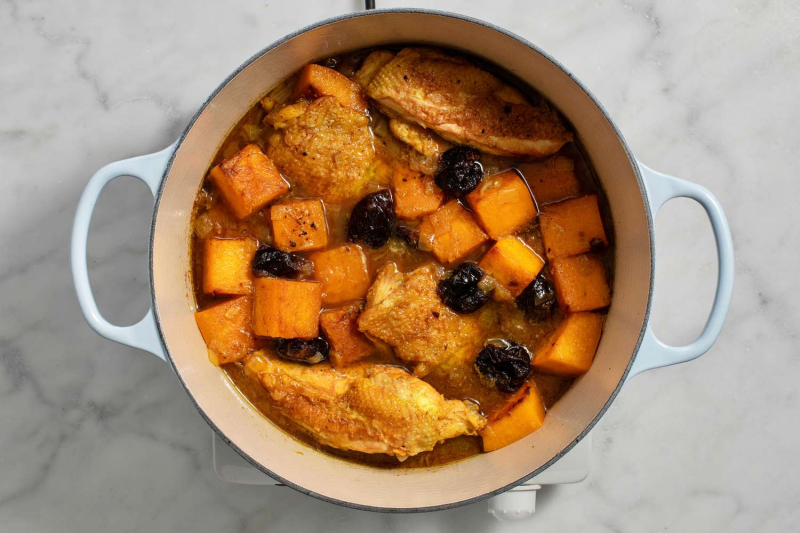
-
Pour in the saffron water and gently stir and remove from the heat. Allow the stew to rest for 10 minutes before transferring it to a serving platter.
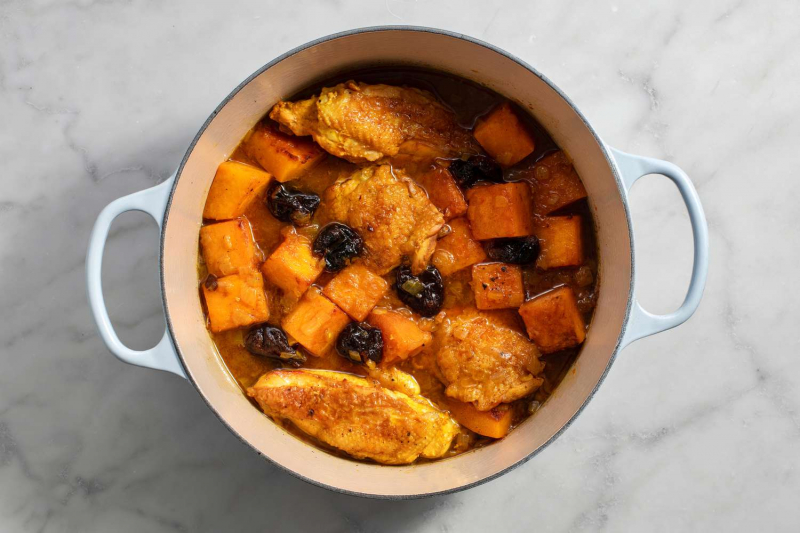
-
Garnish with pistachios and serve with steamed basmati rice or flatbreads.
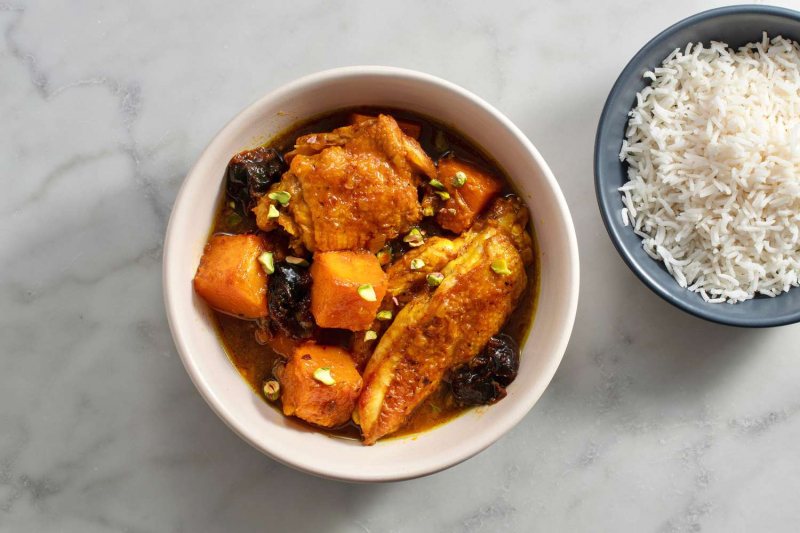
Recipe Variations
- Instead of sauteing, butternut squash can be tossed with a couple of tablespoons of oil and a sprinkling of salt and roasted in the oven at 375 F for 15 minutes.
- Butternut squash can be replaced by sugar pumpkin or your favorite variety of winter squash.
- Previously roasted chicken, including store-bought, can be repurposed and integrated into this stew. Reduce the cooking time to 30 minutes.
- Khoresh Kadu Halvaee can be served with beef or lamb instead of chicken.
Recipe Tip
Butternut squash can be prepared up to 2 days ahead and kept in the refrigerator.
How to Store
Store the leftover stew in an airtight container in the refrigerator for up to 3 days or in the freezer for up to 1 month. Reheat in a covered skillet over medium-low heat, adding a small amount of water as necessary.
| Nutrition Facts | |
|---|---|
| Servings: 4 | |
| Amount per serving | |
| Calories | 621 |
| % Daily Value* | |
| Total Fat 30g | 39% |
| Saturated Fat 7g | 36% |
| Cholesterol 166mg | 55% |
| Sodium 786mg | 34% |
| Total Carbohydrate 62g | 23% |
| Dietary Fiber 11g | 39% |
| Total Sugars 29g | |
| Protein 35g | |
| Vitamin C 38mg | 188% |
| Calcium 139mg | 11% |
| Iron 4mg | 20% |
| Potassium 1355mg | 29% |
| *The % Daily Value (DV) tells you how much a nutrient in a food serving contributes to a daily diet. 2,000 calories a day is used for general nutrition advice. | |